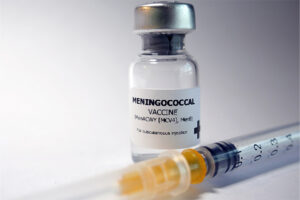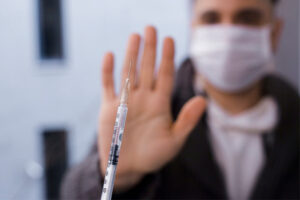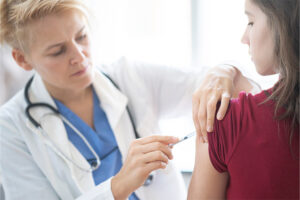Infectious Diseases
Adolescent Vaccinations
Preventing Meningococcal Disease: Current Status and Future Prospects
Overview
Currently, both meningococcal conjugate (MenACWY) and serogroup B meningococcal (MenB) vaccines are needed to fully protect people against invasive meningococcal disease (IMD). MenABCWY vaccine candidates are in late-stage clinical development and could serve to improve coverage rates and increase protection among adolescents.
Expert Commentary
Gary S. Marshall, MD
|
|
“While the uptake of vaccinations against meningococcal disease has increased, these numbers mean that there is substantial room for improvement in getting adolescents fully protected. Vaccines that combine all clinically important serogroups—A, B, C, W, and Y—are in late stages of development and are on the horizon, and I think that the use of these could make a big difference and will improve coverage rates among teenagers.”
IMD is rapidly progressive and extremely serious, with case fatality rates as high as 10% to 15%, even with appropriate antibiotic therapy. Whereas some cases do occur during outbreaks, most arise sporadically and unpredictably. Fortunately, however, IMD is rare, with incidence rates of the order of 1 in 1 million in the general population, albeit higher in certain age groups.
Protein-polysaccharide conjugate vaccines against serogroups A, C, W, and Y have been available in the United States since 2005; outer membrane protein vaccines against serogroup B have been available since 2015. These vaccines are safe and immunogenic. Real-world data from the United States suggest that the MenACWY program has contributed to the decline in IMD that has been seen in recent years. Similarly, real-world data from outbreaks of serogroup B disease in South Australia, New Zealand, and the United Kingdom, as well as on US college campuses, demonstrate the effectiveness of MenB vaccines.
With the availability of these vaccines, prevention is possible. The meningococcal immunization program in the United States has focused on the prevention of IMD in high-risk individuals (eg, those of any age with asplenia) and in otherwise healthy adolescents, among whom much of the disease beyond infancy is concentrated. (Infants also have an increased incidence, but a universal meningococcal immunization program in that age group has not yet been adopted.) Among adolescents, college attendance is a risk factor, and this is something that you might include in a discussion of the prevention of IMD with adolescents and their families. It should be noted that B is the most common serogroup causing IMD in teenagers and that almost all college outbreaks in the United States are caused by serogroup B.
Current vaccination recommendations from the Centers for Disease Control and Prevention are for universal MenACWY vaccination at age 11 to 12 years and an MenACWY booster at age 16 years. The recommendation for MenB is slightly different: adolescents (the preferred age is 16 to 18 years) may receive a MenB vaccine based on shared clinical decision making, which means that a conversation about the disease and the vaccine should take place and a decision about vaccination should be reached collaboratively between the patient and provider. MenB is covered under the Vaccines for Children Program and by most insurance plans.
Coverage rates for the first dose of MenACWY are almost 90%, but second-dose coverage falls off to around 60%. Only approximately 30% of adolescents receive at least 1 dose of MenB. While the uptake of vaccinations against meningococcal disease has increased, these numbers mean that there is substantial room for improvement in getting adolescents fully protected. Vaccines that combine all clinically important serogroups—A, B, C, W, and Y—are in late stages of development and are on the horizon, and I think that the use of these could make a big difference and will improve coverage rates among teenagers.
References
Centers for Disease Control and Prevention. Mbaeyi S, Duffy J, McNamara LA. Chapter 14: meningococcal disease. In: Hall E, Wodi AP, Hamborsky J, Morelli V, Schillie S, eds. Epidemiology and Prevention of Vaccine-Preventable Diseases. 14th ed. Public Health Foundation; 2021.
ClinicalTrials.gov. Immunogenicity and safety study of GSK's MENABCWY vaccine in healthy adolescents and adults previously primed with MenACWY vaccine. Updated June 5, 2023 Accessed July 12, 2023. https://classic.clinicaltrials.gov/ct2/show/NCT04707391
ClinicalTrials.gov. MenABCWY noninferiority study in healthy participants ≥10 to <26 years of age. Updated April 18, 2023. Accessed July 12, 2023. https://classic.clinicaltrials.gov/ct2/show/NCT04440163
Kuhdari P, Stefanati A, Lupi S, Valente N, Gabutti G. Meningococcal B vaccination: real-world experience and future perspectives. Pathog Glob Health. 2016;110(4-5):148-156. doi:10.1080/20477724.2016.1195072
Ladhani SN, Andrews N, Parikh SR, et al. Vaccination of infants with meningococcal group B vaccine (4CMenB) in England. N Engl J Med. 2020;382(4):309-317. doi:10.1056/NEJMoa1901229
McNamara LA, Shumate AM, Johnsen P, et al. First use of a serogroup B meningococcal vaccine in the US in response to a university outbreak. Pediatrics. 2015;135(5):798-804. doi:10.1542/peds.2014-4015
Packnett ER, Zimmerman NM, Novy P, Morgan LC, Chime N, Ghaswalla P. Meningococcal serogroup B vaccination series initiation in the United States: a real-world claims data analysis. Hum Vaccin Immunother. 2023;19(1):2165382. doi:10.1080/21645515.2023.2165382
Parikh SR, Campbell H, Bettinger JA, et al. The everchanging epidemiology of meningococcal disease worldwide and the potential for prevention through vaccination. J Infect. 2020;81(4):483-498. doi:10.1016/j.jinf.2020.05.079
Pingali C, Yankey D, Elam-Evans LD, et al. National vaccination coverage among adolescents aged 13-17 years — National Immunization Survey — teen, United States, 2021. MMWR Morb Mortal Wkly Rep. 2022;71(35):1101-1108. doi:10.15585/mmwr.mm7135a1
Recommended vaccinations for children 7 to 18 years old, parent-friendly version: United States, 2023. Centers for Disease Control and Prevention. Reviewed February 10, 2023. Accessed June 7, 2023. https://www.cdc.gov/vaccines/schedules/easy-to-read/adolescent-easyread.html











